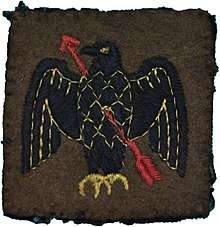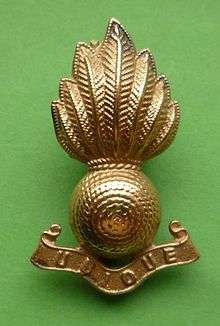134th (Mixed) Heavy Anti-Aircraft Regiment, Royal Artillery
134th (Mixed) Heavy Anti-Aircraft Regiment was an air defence unit of Britain's Royal Artillery formed during World War II. It was one of the first 'Mixed' regiments in which women of the Auxiliary Territorial Service were integrated into the unit's personnel. It defended Birmingham and that portion of the West Midlands before being disbanded in 1955 following the disbandment of Anti-Aircraft Command (AA Command).
| 134th (Mixed) HAA Regiment, RA | |
|---|---|
 Royal Artillery cap badge | |
| Active | 22 September 1941–3 October 1955 |
| Country | |
| Branch | |
| Role | Air defence |
| Size | Regiment (3–4 batteries) |
| Part of | Anti-Aircraft Command |
| Engagements | Air defence of the West Midlands |
Organisation

By 1941, after two years of war Anti-Aircraft Command, tasked with defending the UK against air attack, was suffering a manpower shortage. In April its commander-in-chief, Lieutenant-General Sir Frederick 'Tim' Pile, proposed to overcome this by utilising the women of the Auxiliary Territorial Service (ATS). The ATS was by law a non-combatant service, but it was decided that Defence Regulations permitted the employment of women in anti-aircraft (AA) roles other than actually firing the guns. They worked the radar and plotting instruments, range-finders and predictors, ran command posts and communications, and carried out many other duties. With the increasing automation of heavy AA (HAA) guns, including gun-laying, fuze-setting and ammunition loading under remote control from the predictor, the question of who actually fired the gun became blurred as the war progressed. The ATS rank and file, if not always their officers, took to the new role with enthusiasm and 'Mixed' batteries and regiments with the ATS supplying two-thirds of their personnel quickly proved a success.[1][2][3][4]
_serving_with_a_3.7-inch_anti-aircraft_gun_battery%2C_December_1942._TR455.jpg)
The first of these new units, 435 (Mixed) HAA Battery, took over an operational gun site in Richmond Park, south-west London, in August 1941, and a full regiment of converted batteries soon followed. The next group of mixed regiments was formed on 22 September 1941, including 134th (Mixed) Heavy Anti-Aircraft Regiment, whose regimental headquarters formed in Kings Heath, Birmingham.[5] It was then joined by the following batteries:[3][5][6]
- Regimental Headquarters (RHQ) formed on 22 September 1941 in Kings Heath, Birmingham
- 456 (M) HAA Bty formed on 10 July 1941 from 205th HAA Training Rgt, Arborfield, from a cadre provided by the 91st HAA Regt, became mixed on 27 August 1941, and regimented with 134th (M) HAA Rgt on 20 October.
- 459 (M) HAA Bty formed on 10 July 1941 from 209th HAA Training Rgt, Blandford Camp from cadre provided by 106th HAA Rgt, became mixed on 27 August and was regimented with 134th (M) HAA Rgt on 20 October
- 460 (M) HAA Bty formed on 10 July 1941 from 210th HAA Training Rgt, Oswestry, from cadre provided by 111th HAA Regt, became mixed on 20 August and was regimented with 134th (M) HAA Rgt on 13 October
- 461 (M) HAA Bty formed on 10 July 1941 from 211th HAA Training Regiment, Oswestry, from cadre provided by 81st (Cheshire) HAA Rgt, became mixed on 20 August and was regimented with 134th (M) HAA Rgt on 13 October
Deployment

The new regiment was assigned to 34th (South Midland) Anti-Aircraft Brigade, part of the 11th Anti-Aircraft Division operating the West Midlands and Wales inner AA defence zone.
On 3 June 1942 the regiment provided a cadre to the 209th HAA Training Rgt based at Blandford Camp to form 559 HAA Bty but this formation was cancelled on 14 May. That same day, the regiment provided another cadre to the 210th HAA Training Rgt based in Oswestry to form 559 HAA Bty which was regimented into 168th HAA Rgt on 15 August 1942.[6][7]
On 15 August 1942 456 (M) HAA Bty left the regiment to join the 168th (M) HAA Rgt, so on 29 July, a cadre was provided by 126th HAA Rgt to the 207th Training Rgt in Devizes, and regimented into the 134th (M) HAA Rgt on 19 October but later disbanded on 8 January 1945.[5][6]
On 10 August 1945 the regiment was re-organised as the 134th Heavy Anti-Aircraft Regiment, Royal Artillery (TA) losing their ATS personnel, which made them no longer mixed. Eventually on 1 January 1947 the regiment was re-designated as the 93rd Heavy Anti-Aircraft Regiment, Royal Artillery with the batteries being redesignated as 268, 269, and 270 HAA Btys respectively. The regiment was then renamed as the 493rd (Mixed) Heavy Anti-Aircraft Regiment, Royal Artillery (TA) and based in Birkenhead, Cheshire under the 59th AA Brigade (TA). When AA Command was disbanded on 3 October 1955, the regiment was amalgamated with the 349th LAA Rgt and 576th (M) LAA/SL Rgt to form the 441st Light Anti-Aircraft/Searchlight Regiment, Royal Artillery.[5][8][9]
Insignia

While the male members of the regiment wore the Royal Artillery's 'gun' cap badge, the women wore the ATS cap badge, but in addition they wore the RA's 'grenade' collar badge as a special badge above the left breast pocket of the tunic. Both sexes wore the white RA lanyard on the right shoulder.[10]
Notes
- Pile's despatch.
- Collier, Chapter XVII.
- Routledge, pp. 399–400.
- Routledge, pp. 338, 407.
- Frederick, p. 785.
- Frederick, p. 759-63.
- Frederick, p. 793.
- Litchefield, p. 32.
- Frederick, p. 1018.
- Sainsbury, Plate 9, p. 7.
References
- Basil Collier, History of the Second World War, United Kingdom Military Series: The Defence of the United Kingdom, London: HM Stationery Office, 1957.
- J.B.M. Frederick, Lineage Book of British Land Forces 1660–1978, Vol II, Wakefield, Microform Academic, 1984, ISBN 1-85117-009-X.
- Gen Sir Frederick Pile's despatch: 'The Anti-Aircraft Defence of the United Kingdom from 28th July, 1939, to 15th April, 1945' London Gazette 18 December 1947
- Brig N.W. Routledge, History of the Royal Regiment of Artillery: Anti-Aircraft Artillery 1914–55, London: Royal Artillery Institution/Brassey's, 1994, ISBN 1-85753-099-3
- Col J.D. Sainsbury, The Hertfordshire Yeomanry Regiments, Royal Artillery, Part 2: The Heavy Anti-Aircraft Regiment 1938–1945 and the Searchlight Battery 1937–1945; Part 3: The Post-war Units 1947–2002, Welwyn: Hertfordshire Yeomanry and Artillery Trust/Hart Books, 2003, ISBN 0-948527-06-4.
- Norman E.H. Litchfield, The Territorial Artillery 1908–1988 (Their Lineage, Uniforms and Badges), Nottingham: Sherwood Press, 1992, ISBN 0-9508205-2-0.